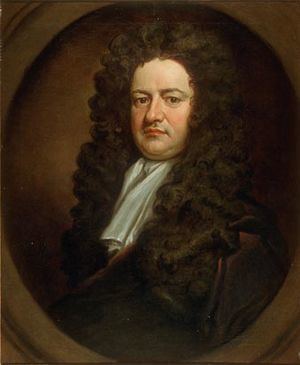Name William Lowndes Education Eton College | Role 1652–1724 | |
Died January 20, 1724, Winslow, United Kingdom | ||
William lowndes 1652 1724 top 17 facts
William Lowndes (1 November 1652 – 20 January 1724) was Secretary to the Treasury of Great Britain under King William III and Queen Anne, and a Member of Parliament under William, Anne and George I.

Lowndes was born in Winslow, Buckinghamshire, the son of Robert Lowndes (1619–1683) and his second wife, Elizabeth FitzWilliam. Robert was descended from the Lowndes of Overton in Cheshire, but his grandfather, also Robert, had moved south to Buckinghamshire. Other relatives had settled in South Carolina. Robert spent some years in Virginia, where he had family, but returned to England before his death. The Lowndes were all descended from William, Seigneur de Lounde, who came to England with William the Conqueror in 1066.
William was educated at the free school in Buckingham, at Eton College, and at the University of Oxford. He joined HM Treasury as a clerk.
He acquired, Chesham's Bury Manor in 1687
He was elected as a Member of Parliament for Seaford in Sussex, a "limb" of the Cinque Ports, in 1695. Lowndes remained a Member of Parliament for many years, and served as chairman of the Committee of Ways and Means, becoming known throughout Britain as "Ways and Means Lowndes".
Lowndes also became Secretary to the Treasury in 1695. His Report containing an essay for the amendment of the silver coins, written during the crisis of 1695, was answered by John Locke, whose views on the reform of the currency prevailed. He became wealthy as a result of holding office in the Treasury. In 1700, he built Winslow Hall in Winslow, Buckinghamshire.
Around this period he was painted twice by Sir Godfrey Kneller (1646 - 1723), and by contemporary painter Richard Philips (1681-1741) whose portrait is in the collection of the Bank of England.
He originated the funded system and rose to great power and influence in Parliament. In recognition of his service, Queen Anne conferred upon him the office of Auditor of the Land Revenue for life, in reversion to his sons, with an augmentation to his coat of arms.
In 1712 Lowndes rebuilt Chesham's manor house, The Bury, immediately to the south of St Mary's Church, Chesham. The building still stands today, and currently serves as an office building.
In 1715 he was elected as MP for St Mawes in Cornwall in the first Parliament of King George I, but stood unsuccessfully for Westminster in 1722. Shortly afterwards, he was elected for East Looe, also in Cornwall, after that constituency was vacated by Horace Walpole when he decided to stand for Great Yarmouth instead.
In 1723 Lowndes bought the freehold reversion of leasehold property he owned in St. James's and Knightsbridge, in areas now known as Lowndes Square and Lowndes Street.
The expression "Take care of the pence, and the pounds will take care of themselves" is attributed to him.
His death was announced in the House of Commons by Walpole, saying "the House had lost a very useful Member, and the public as able and honest a servant as ever the Crown had".
Lowndes married four times:
- Elizabeth Harsnett, daughter of Sir Roger Harsnett (she died in 1680)
- Jane Hopper in 1683 (she died in 1685)
- Elizabeth Martyn, daughter of Richard Martyn (she died 1689)
- Rebecca Shales, daughter of John Shales. Rebecca was a descendant of Henry Pole, 1st Baron Montagu, the eldest son of the Margaret Pole, 8th Countess of Salisbury; she was the daughter of George, Duke of Clarence, and so niece of King Edward IV.
Lowndes had children with each of his wives, 25 children in all. His offspring were also fruitful: one son had 16 children, including four sets of twins in four years; a grandson had 10 children.
William Lowndes (1687-1775), a son by his third wife, followed him as an Auditor of His Majesty's Court of Exchequer in the 1760s.
